JavaScript seem to be disabled in your browser.
You must have JavaScript enabled in your browser to utilize the functionality of this website.

Edwards Yacht Sales

- 866.365.0706
1994 Caliber 35
- Melbourne, FL, US
Yacht price
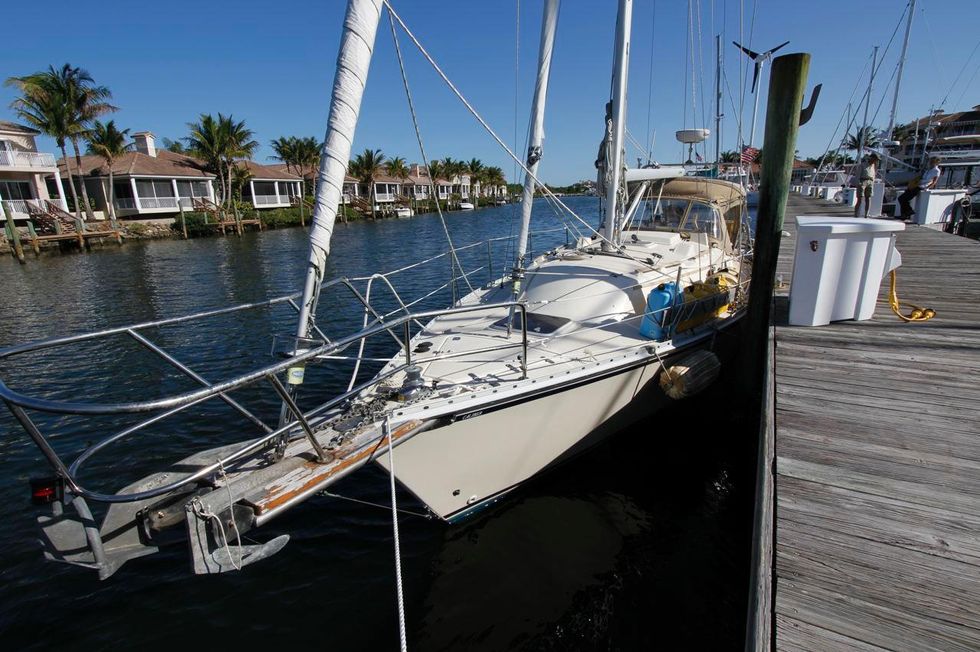
- Email Broker
- Call Broker

Very well maintained and updated Caliber 35 that is sure to catch the attention of the serious cruiser. Re-powered in 2007 with a Yanmar 3YM30, New Rigging in 2007, New Linear Drive Auto Pilot, Raymarine e90 Hybrid Touch in Nav Pod w/Radar in 2010, New Frigoboat Fridge in 2014, Custom Arch w/davits and much more.
NEW LISTING with more specs coming soon.
Specifications
Descriptions, basic information, dimensions & weight.
- View Option

LOA: 35.75 feet LWL: 29.83 feet BEAM: 11.33 feet DRAFT: 4 feet 8 inches Bridge Clearance: 55 feet DISPLACEMENT: 13100 pounds BALLAST: 6100 pounds
Engine(s): Yanmar Engine Model: 3YM30F Model Year: 2007 Hours: 650 Cruising Speed: 5.5 knots Max Speed: 8 knots
Fuel: 40 gallon Water: 60 gallon Holding: 25 gallon
The Caliber 35 clever design and uncompromising craftsmanship continue below decks, in a layout that once more emphasizes comfort and convenience.
Entry to the cabin is easy by way of our accessible companionway and large platform steps. Inside, we’ve taken advantage of the Caliber 35’s beam to create a luxurious live-aboard interior. The interior is well-illuminated and richly finished in teak. The Main Salon features ample seating on two settees. The twin-leaf dining table folds up against the bulkhead for additional room. The Forward Sleeping Cabin can be closed off from the Main Salon for true privacy. The aft cabin berth is big enough for guest or can be used as a convenient sea berth.
The Head has two doors, one connection the Forward Cabin and one the Main Salon, so it can be accessed from either area without disturbing the other’s occupants! While it’s enclosed and private, the Head is also spacious.
Any cook will appreciate the Caliber 35’s efficient U-Shaped Galley. Included is a two-burner Galley Maid propane stove/oven, microwave, dual deep stainless sinks, Seagull IV Water Purifier system (2010) and a new Fridgoboat 12Vdc refrigeration/freezer (2014). Ample storage for food and utensils, and more than enough counter space to prepare multi-course meals.
Ventilation on the Caliber 35 is outstanding, with eleven (11) opening portholes, five (5) overhead hatches, and two (2) deck cowls each strategically place for optional air circulation.
ST 70 Raymarine Linear Drive Auto Pilot (2010) Raymarine e90 Hypbrid Touch GPS Chartplotter in Nav Pod (2010) Raymarine 2kw HD Digital Radar Dome (2010) ST60+ Wind Speed and ST60+ Tridata (Depth, Speed, Sound) Sirius XM Weather and Audio (2009) Jensen Siruis XM CD/FM/AM Stereo Command Mic II at Helm Icom IC-M422 VHF Radio w/AIS receiver
30A 110Vac Input 30A Electrical cord (25ft) Balmar 6 series Alternator Isotemp Hot Water Heater (2010) Air Breeze 250 Wind Generator (2011) LED lighting 12Vdc and 110Vac Electrical Panel w/breakers AGM West Marine House Batteries (2011) Zantrex 2000 SW Inverter (2011) Dedicated Starting Battery (2014)
The T-shaped cockpit is roomy and designed for safety and efficiency even when sailing short-handed. All sail control lines are led aft to the cockpit and all winches are self-tailing for one-handed use.
At the stern a boarding platform makes it simple to board a dinghy or take a swim. The platform’s folding ladder can be deployed from the water allowing safe and quick access. A hand held shower provides a rinse-off right on the platform.
New Edson Pedestal (2010) Lewmar Folding Wheel (2010) New Chains 'n Cables (2010) Bimini and Dodger (2010) Side Panel Screens (2010) Custom Arch w/Dinghy Davits (2011) Edson Outboard Motor Mount Closed Cell Cockpit Cushions Nav Equipment in Pod (listed in Electronics) Richie Compass Shower on Transom
The Caliber 35 has a distinctive dual anchor roller platform. Sturdily constructed of teak and stainless, the platform simplifies anchor handling and reduces the risk of the anchor chipping the hull’s gel coat.
Lofrans 1000W Windlass Up and Down (2011) Rocna Anchor 45 lb 100 ft HT G4 chain 50 ft rode Bruce Anchor 30 ft HT G4 chain 150 ft rode Wash Down at Bow
New Rigging in 2007 Profurl Furlers (2007) In Mast Furling Main 135% Furling Head Sail Cutter Rig Staysil Zspar Mast and Boom
Presented by
Kevin welsh 14 listing(s).
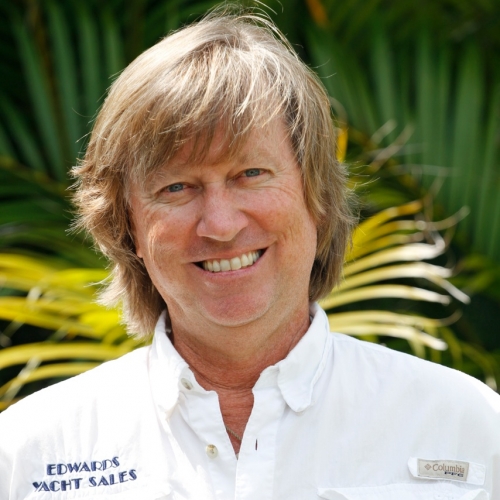
- 321.693.1642 727.449.8222
- View Profile
Manufacturer
Length Range Length Range
Year Range Year Range
Price Range Price Range
QUICK SEARCH BY:
Buyer services, featured yacht.

2019 Monachus Issa 45
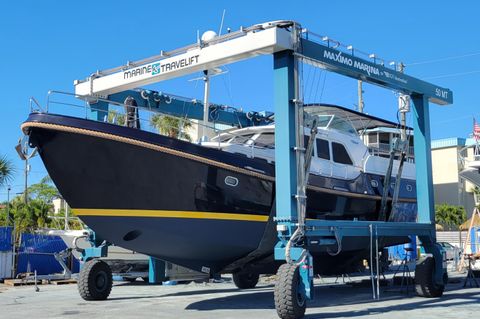
2002 Linssen 470 Grand Sturdy
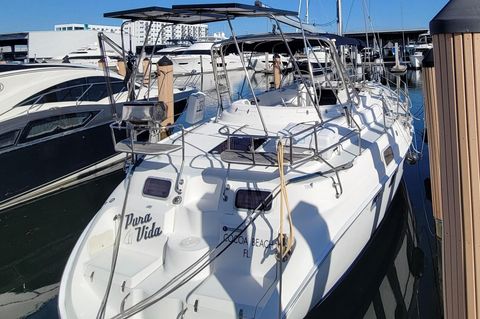
2002 Hunter 450 Passage

2007 Sea Ray Sundancer 40
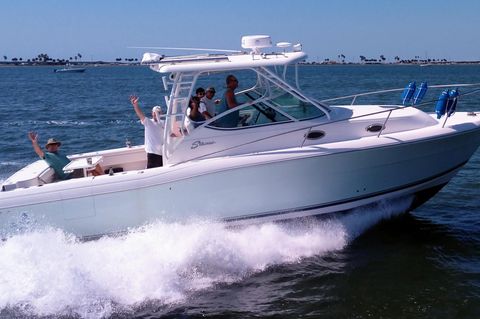
2021 Stamas 390 Aegean

1985 Ocean Yachts 55 Super Sport

1981 Hatteras 48 Motor Yacht

2007 Meridian 391 Sedan

1996 Tiara Yachts 3500 Express

1985 Morgan 31 Off Shore Fishing Cuddy

2001 Wellcraft Martinique 3700
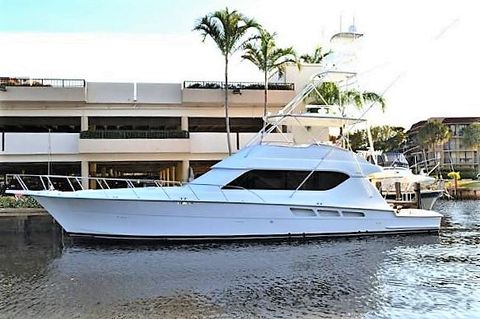
2001 Hatteras Sportfish
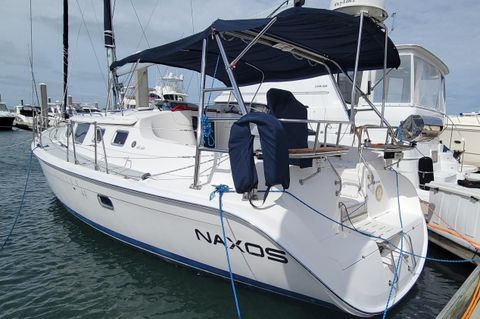
2007 Hunter 44 Deck Salon
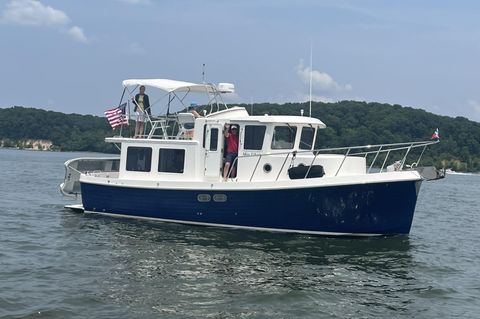
2006 American Tug 34 Pilothouse Trawler
- Google Plus
- Boats For Sale
- Brokerage Services
- Sold Yachts
Whether you are buying or selling your next boat or your first boat, one of Edwards Yacht Sales 45+ Professional Yacht Brokers throughout the Southeast are here to assist. Since 2003 we have acted as our clients trusted advisor throughout the entire process from shopping, to making an offer, to sea trial and survey, to closing.
Corporate Office: 510 Brookside Drive Clearwater, FL 33764
Email: [email protected]
Phone: 727.449.8222 Toll Free: 866.365.0706 Fax: 727.298.0456
Copyright © 2024 Edwards Yacht Sales Do Not Sell My Personal Information Powered by YachtCloser

We have placed cookies on your device to help make this website better.
You can use this tool to change your cookie settings. Otherwise, we’ll assume you’re OK to continue.
Some of the cookies we use are essential for the site to work.
We also use some non-essential cookies to collect information for making reports and to help us improve the site. The cookies collect information in an anonymous form.
To control third party cookies, you can also adjust your browser settings .
- New Sailboats
- Sailboats 21-30ft
- Sailboats 31-35ft
- Sailboats 36-40ft
- Sailboats Over 40ft
- Sailboats Under 21feet
- used_sailboats
- Apps and Computer Programs
- Communications
- Fishfinders
- Handheld Electronics
- Plotters MFDS Rradar
- Wind, Speed & Depth Instruments
- Anchoring Mooring
- Running Rigging
- Sails Canvas
- Standing Rigging
- Diesel Engines
- Off Grid Energy
- Cleaning Waxing
- DIY Projects
- Repair, Tools & Materials
- Spare Parts
- Tools & Gadgets
- Cabin Comfort
- Ventilation
- Footwear Apparel
- Foul Weather Gear
- Mailport & PS Advisor
- Inside Practical Sailor Blog
- Activate My Web Access
- Reset Password
- Pay My Bill
- Customer Service

- Free Newsletter
- Give a Gift

How to Sell Your Boat

Cal 2-46: A Venerable Lapworth Design Brought Up to Date

Rhumb Lines: Show Highlights from Annapolis

Open Transom Pros and Cons

Leaping Into Lithium

The Importance of Sea State in Weather Planning

Do-it-yourself Electrical System Survey and Inspection

Install a Standalone Sounder Without Drilling

Rethinking MOB Prevention

Top-notch Wind Indicators

The Everlasting Multihull Trampoline

In Search of the Snag-free Clew

What’s Involved in Setting Up a Lithium Battery System?

Reducing Engine Room Noise

Breaking Point: What Can Go Wrong With Your Yanmar?

Mildew-resistant Caulks for Boats


Can We Trust Plastic Boat Parts?

Repairing Molded Plastics

Mailport: Marine plywood, fuel additives, through bolt options, winch handle holders

The Day Sailor’s First-Aid Kit

Choosing and Securing Seat Cushions

Cockpit Drains on Race Boats

Rhumb Lines: Livin’ the Wharf Rat Life

Safer Sailing: Add Leg Loops to Your Harness

Resurrecting Slippery Boat Shoes

Tricks and Tips to Forming Do-it-yourself Rigging Terminals

Marine Toilet Maintenance Tips

Learning to Live with Plastic Boat Bits

The Ultimate Guide to Caring for Clear Plastic
- Sailboat Reviews
The more moderate younger sister of the giant-killing Cal 40 proves a balanced, capable cruiser. Essential structures are reported to be very strong, while reviews of the interior finish are mixed.
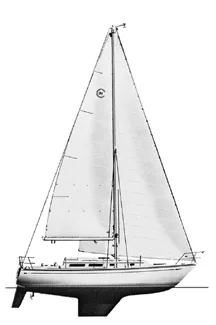
When you create a boat that’s universally celebrated as “the most successful production raceboat ever,” what do you do for an encore? In 1966 the Cal 40 capped a famous string of grand prix victories when Thunderbird (with designer Bill Lapworth and America’s Cup helmsman Bus Mosbacher aboard) won the Newport-Bermuda Race while sister ships placed 1-3-4-5-6 in Class D. Coming as it did after three successive TransPac victories and an SORC title, the performance confirmed the 40-footer as the hottest thing around, inspired a “Stamp out Cal 40s” movement, and offered an off-the-shelf way to win in a league where only custom designs had been able to play.
For designer Lapworth and builder Jack Jensen there followed an “if it ain’t broke, don’t fix it” string of racer/cruisers built on Cal 40 principles. Some of Jensen Marine’s many boats (at least 20 models over the years) have been full-cruising “performance motorsailers” like the Cal 46, but the vast majority were racer/cruisers. Virtually all of those were descended very directly from the boat that fueled the company’s success, the famous Cal 40.
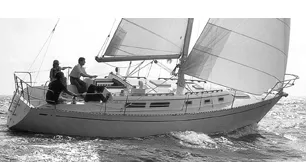
By 1979, when Lapworth and Jensen collaborated (for what turned out to be their final time) on the Cal 35 , the world where once the Cal 40 ruled had changed. The International Offshore Rule (IOR) was no longer the only game in town, spars were spindlier, fins were more blade-like, and racing boats had changed a lot. Sunroofs, swim decks, hull ports, anchor pulpits, and cockpit tables had also, in the meantime, arrived to add new dimensions to cruising. The ideal of a “dual-purpose” boat for racing and cruising was still alive, but the forces driving racers and cruisers apart may never have been so strong.
You only need to read the first sentence of the press release announcing the Cal 35’s debut to see that Jensen Marine saw its new 35 as a balanced, conservative response to those forces of upheaval: “She is quite ‘establishment’ in her attitude toward rewarding sailing but quite ‘individualistic’ in her solution to offshore and dockside accommodations.”
In creating the 35, Jensen Marine stuck with the formula that served it well from the Cal 40 forward: “moderately light displacement, waterlines on the longish side, fin keel, and high-efficiency rudder.” To suit the boat to the times, the publicist adds, “In all candor, however, the new Cal 35 is weighted toward high-performance cruising—real sailors’ cruising.”
While she never won much as a racer, she succeeded in fulfilling that “fast-cruising” formula. That is what has kept her alive on the used-boat market, and why sailors might do worse than to look at her as a couple’s cruiser.
“You can’t please everyone.” Almost 100 Cal 35s were built in the early ’80s, however, and as a designer friend of ours says, “Those stodgy traditional looks seem to get better and better the more time goes by.” She’s well-built, sails well, and seems in many ways to justify the premium price that’s attached to the Cal name.
“I sailed the hell out of mine for 18 years and I’ve never had a boat that I loved more,” one owner told us.
Design Nathanael Herreshoff was among the first to design a spade rudder, but offshore racers didn’t get to steer with them until Lapworth came forward with the Cal 40. We can remember the “night and day” experience of our first trick at the tiller of one of the Jensen Marine boats. The helm combined sensitivity and control in amounts that were astounding. “The spade” made keel-hung rudders seem as outmoded as cotton sails. We couldn’t help but notice, however, that the balance on those early rudders was overlarge—under power they seemed to exercise a mind of their own; keeping the boat tracking with the engine pushing her took full-time concentration.
Lapworth has no patent on the other signature element of the Cal 40—the fin keel. But, married with the balanced spade, it cut underbodies loose from long-keel bondage and opened the way for lift-producing foils and struts to follow. It made surfing a way of life, and opened up the offshore world to dinghy-like standards of performance and speed.
The underwater elements of the Cal 35, however, don’t show much advancement beyond the pioneering Cal 40 underbody. While European and American naval architects of the late ’70s and early ’80s shaved wetted surface and made their foils higher aspect (thus more efficient at producing lift) the Cal 35 took a middle route, somewhat in keeping with the boat’s “please everybody” mission, with a conservatively thick section, long chord length, and low aspect-ratio planform. She thus has plenty of get-up when the wind is free and strong but is at her worst upwind in light air and/or chop.
Lapworth always championed light boats. Some West Coast featherweights may have been more extreme, but his “get the lead out” efforts were another big reason why his Cals were so hard to beat. The Cal 35, however, displaces just 2,000 pounds less than the Cal 40. Comparing sail area/displacement numbers shows that the newer, smaller boat looks better on the calculator (18.2 versus the Cal 40’s 17.7) but in a racing world where spade rudders and fin keels are old hat, and where the push for speed potential is constant, such a small gain seems very little to show for 20 years’ worth of design development.
Lapworth did concentrate on finer bows with his later designs. The entry on the 35 (and the designs that directly preceded her) was sharpened materially “to help the boat in slop and chop.” The clean sweep of the waterlines, and the flat deadrise aft, make her surf relatively easily, but when you compare her to the virtual planing shapes of her dishier modern competitors, it’s a case of obsolescence at best.
The 35 has a ballast/displacement ratio of 40%. That is robust, but modern racers push that stability-producing number higher. The J/35, for instance, carries a figure of 45%. Despite carrying a lot of lead, the Cal 35, like all the Cal boats, has it encapsulated in a resin matrix within a fiberglass keel. That effectively reduces the density of the fin and accounts in good measure for her performance review as “somewhat tender.”
Another reason why she has to reef before her competitors is that her hull shape, although clean and surf-ready, is a bit narrower and has softer chines than the majority of the boats that came after her.
Cals were never beauty queens. Their aesthetic has a lot to do with function. The short-ended, lean and mean look of the Cal 40 derived much of its appeal from her place in the winners’ circle. The Cal 35 is cut from the same cloth, but, because of her emphasis on the cruising side of the ideal, she has softer, prettier styling than her ruthless forebear.
Her sheer is straight without being knife-edge, her stem is elongated and more delicate than the 40’s, she has almost no counter, and her transom is delicately reversed. The house is broken out into big windows and little ports. Dorade boxes on either side of the companionway form part of her look. She’s as middle-of-the-road in appearance as she was meant to be in function.
Construction When Jack Jensen, a mechanical engineer with little or no background in boats, established Jensen Marine and started building Lapworth designs in 1958, there weren’t many other production builders around. His thought, it’s been written, was “that production-line construction of small fiberglass auxiliaries would work.” Starting with the Cal 24 (an immediate success) and the Cal 20 (over 1,700 sold) he and Lapworth confirmed that wisdom.
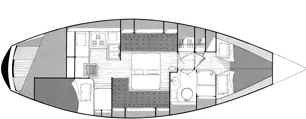
Early in the company’s evolution Jensen developed some of the basics that remained his hallmarks. Rather than use a fiberglass pan as a structural grid or locater for interior furniture, Cal built the entire interior outside the hull. There were some efficiencies with the technique, but the prime virtue was that (once the wooden framework was dropped into place) it allowed access all around the interior so that it could be taped to the hull in a number of different places rather than being left to “float” as it would be in the areas beneath a pan. This building method exposes a significantly greater amount of wood in the bilge, but high-quality plywood and careful taping have kept rot problems to a minimum.
The 35’s hull is solid glass. A sailor who bought his Cal 35 in 1980 wrote: “Mine was one of the very last boats laid up in Costa Mesa. I’ve heard that the boats built later in Tampa had blistering (and some other problems). I’d advise anyone looking at Cals built after 1982 (when the move to Tampa occurred) to check this out.”
Moderate blistering was reported by a handful of owners from our survey.
The deck is plywood cored. Said one owner of a 1983 boat, “The only problem I’ve had was having to take up a 12-square-foot section of deck and replace the plywood coring.” A number of others however, report gelcoat crazing at corners and stress points.
Cal decks have been joined to the hull in several ways, but the method evolved with the 35 has earned several owner reports that they’ve had no leaks through season after season. The hull is built with an inward-turning flange. The deck, built with a down-turning flange, is dropped over the hull and the joint is bedded with sealant. The edge is then capped with a perforated aluminum toerail that is bolted both horizontally and vertically to anchor the joint. No one came forward to report deck leaks, though some owners have had their boats for 20 years or more.
One Long Island owner wrote that, “My boat took on major water due to the design of her anchor locker drains, as well as the mounting for the cutless bearing strut.” He concluded that his Cal 35 was “a beautiful sailing boat that was rather poorly built.” That owner’s report, however, seems to be an aberration. We’ve received testimony from a good number of owners who confirm that the “well-built” reputation Cals have earned over the years is well-deserved.
Accommodations Though brochures called the Cal 35 “what may be the most thoroughly thought-out performance cruising yacht ever offered the sailing world,” there isn’t much below that you haven’t seen before. Part of the thinking, in fact, was to redesign her interior after only 50 boats were sold in the first three years of production—a molasses-like pace for Cal at the time. The boat originally had a head aft and galley opposite. “I have the original layout,” says one owner from 1981. “I still think it makes an excellent couples boat. Who needs all of those bunks anyway?”
The “Mark II” version is more standard. The 6’4″ headroom hasn’t changed, but the floorplan has. The Mark II setup offers a quarter berth aft, two settee berths in the saloon, and a substantial platform double in the forepeak. The arrangement showcases a truly well-designed head/shower with maximum elbow room, light, and ventilation. It is sited in the “traditional” spot forward of the saloon. Double sinks on the centerline are another good addition.
There’s a distinctively traditional handling of teak and holly in the sole through teak accents, as well as teak cabinet fronts, ceiling panels, and bunk bases. One owner told us, “The 35 isn’t a boat you’d buy for the furniture—they did cut some corners here and there below.”
As is typical in galleys on boats this size, the bottom of the icebox is hardly accessible if you’re not six feet tall. And, complained one owner of a boat new in 1980, “the icebox is large but not well-insulated.” A second agreed. Though access was a critical problem, he removed the foam battens from around the box and foamed the entire cavity. “I’m very happy with the upgrade,” he said.
The drop-leaf table in the saloon is a big improvement over the clumsy mast-mounted table that it replaces. The electronics storage seems very minimal when measured by modern standards. Ventilation is better than average thanks to the well-sited (for air, not sail-handling) Dorade vents, six opening ports, and opening overhead hatch. The standard hatch in the forepeak, however, leaks. Stowage includes a pleasing number of drawers.
Performance One place where the 35’s clean lines, long waterline, and moderate displacement really shine is under power. The standard Universal 32-hp four-cylinder diesel consistently pushes her past her 7-knot hull speed and consumption at cruising speed is less than a gallon per hour. “I have a Martec prop,” one owner says. “I like it for sailing, but it sometimes doesn’t open fully when I change gears.”

Several owners rated noise and vibration as “very smooth and quiet.” Some also felt that the Cal 35 “walked” excessively (backed to port) in reverse. “But the big spade rudder and smallish fin give her a very small turning circle.”
If you take the Cal 35 onto most race courses you won’t be as dominant as the early Cal 40s. For one thing, 13,000 pounds hardly qualifies as even “moderately light” these days. In the world of drop-keeled rockets and winged speed merchants you might call something like a J/105 (just 6 inches shorter than the Cal 35) “moderately light.” Weighing in at 7,750 pounds, that modern J has a displacement/length ratio of 135. (The lower the number, the lighter the boat.) Compare that to the Cal 35’s D/L of 242 and you can see how much the whole concept of light displacement has changed.
One Chesapeake sailor who calls his boat an excellent cruiser/racer said, “I have tried to turn her into a racer/cruiser under PHRF. It worked for two to three years, but after the measurers lowered my rating and new lightweight boats came into the area, I don’t feel that I can continue to compete. I’m going to try IMS next season, add a full-battened mainsail, and install a Hall Quik Vang to keep the sail from getting chewed up by the topping lift.”
While there is variation from fleet to fleet, the Cal 35 rates around 160 under PHRF. Neither a “sleeper” like some re-vamped ’80s boats, nor a rocket like the original 40, capable of running away from her competitors no matter what the rating, the Cal 35’s racing success has been middling at best. However, in terms of efficient, mannerly, seakindly sailing of the sort that makes for superlative cruising, this old boat delivers the goods. While her relatively bluff bow puts her at a disadvantage in light air with waves, her full entry helps the boat ride high and dry, especially while surfing down waves. Flat sections forward of the keel can cause pounding, but they are also a key to the boat’s crisp and surprisingly fluid motion. Chopped off at the transom she maxes out her waterline; high-sided forward she is dry on deck.
Though her mainsail is, in the fashion of the ’80s, smaller than her foretriangle, it is large enough to make main- alone sailing not only possible but pleasurable.
Like the Cals before her, the 35 has inboard shrouds to facilitate tight sheeting angles as well as let people walk the side decks with ease.
Several owners felt the need to relocate the pedestal 4 inches forward and install a 36-inch wheel in place of the standard 28-incher. “The Barient 25s that came with the boat were too small,” said a sailor from the Great Lakes. “I took them off and installed 28s.”
The mainsheet arrangement called for a number of parts and what amounted to two travelers, one on the housetop and the other on a horse over the companionway. Several sailors found the set-up “poorly designed” and over-complicated.
Conclusions Whoever wrote the brochure back in 1980 had it right—the Cal 35 is more of a cruiser than a racer. It’s impossible, though, to dissociate the Cal name from the fin-keeled surfing machine that grabbed all of the headlines back in the ’60s.
The good things about buying into a racing family seem to us to include the satisfaction that your boat is, in at least one sense, pedigreed for performance. There comes an association with people who are at the top of the sport, and no company exemplifies the halcyon days of the racer/cruiser (or cruiser/racer, whichever you prefer) than Cal.
Among the shortcomings of this set-up are the possibility that you’re paying for reputation and prestige instead of solid value; that the people at the top are so worried about staying there that they have little time for their customers, and that competitive excellence can sometimes provide a screen that hides corners that have been cut. We don’t think this is true in any serious way about the Cal 35. She’s a solid chip off the Cal block.
At press time, Internet asking prices for used Cal 35s average around $43,000, not including one 1985 Mark II boat offered in what appears to be pristine condition at $70,000.
After changing hands several times, Cal finally folded in 1989. For more on the Cal 35 and Cal boats in general, try joining the Cal owners’ e-mail discussion list at www.sailnet.com .
Also With This Article Click here to view “Owners’ Comments.”
RELATED ARTICLES MORE FROM AUTHOR
Excellent and informative. buying a boat ,trying to decide between a 1984 cal 35 Mk11 or a 1984 endeavor 33 sloop “Any advice”
LEAVE A REPLY Cancel reply
Log in to leave a comment
Latest Videos

Island Packet 370: What You Should Know | Boat Review

How To Make Starlink Better On Your Boat | Interview

Catalina 380: What You Should Know | Boat Review
- Privacy Policy
- Do Not Sell My Personal Information
- Online Account Activation
- Privacy Manager
The Caliber 35 is a popular sailboat designed and built by Caliber Yachts. With a length overall of 34 feet, 8 inches and a beam of 11 feet, the Caliber 35 is a versatile and capable cruiser that can handle a wide range of sailing conditions. The boat's sturdy construction, with a hand-laid fiberglass hull and deck, provides both safety and comfort for extended periods of time at sea. The design of the Caliber 35 also features a spacious and well-appointed interior, making it an ideal choice for live-aboard sailors or weekend adventurers.
One of the standout features of the Caliber 35 is its performance under sail. The boat is known for its stability and responsiveness, even in challenging wind and sea conditions. It also has a relatively shallow draft, which allows it to navigate in waters that are off-limits to deeper-draft vessels. Overall, the Caliber 35 is a popular choice among sailors who prioritize safety, comfort, and performance in their cruising sailboat.
LOA: 35.75 ft LWL: 29.83 ft Beam: 11.33 ft Draft: 4.50 ft Displacement: 13100.00 lbs Ballast: 6100.00 lbs Hull type: Fin with rudder on skeg Hull construction: FG Rigging type: Cutter
Caliber 35 for sale in the last 12 months
Below you'll find the latest Caliber 35 listings for the last 12 months. We compare the listing price with boats listed in the past and the color coding indicates if the price is good (green = below the average listing price) or more on the expensive side (red = seller is asking more than the average listing price).
Caliber 35 listing prices over time
Listing details.

- Forum Listing
- Marketplace
- Advanced Search
- About The Boat
- Boat Review Forum
- SailNet is a forum community dedicated to Sailing enthusiasts. Come join the discussion about sailing, modifications, classifieds, troubleshooting, repairs, reviews, maintenance, and more!
Caliber 35 Owners?
- Add to quote
My wife and I are in the market for a liveaboard sailboat that will see mostly coastal cruising (east coast of USA) and island hopping the Bahamas, maybe getting as far as some Caribbean cruising and a jump over to Bermuda. We've been sorting through brochures, websites, magazine reviews, etc for years and have done some tire-kicking on a number of boats. I really like the Caliber 40 but presently we're looking at the Caliber 35 LRC as an alternative, mainly to reduce the long term cost of ownership (from dock fees to upkeep). I've scrounged Yachtworld but it seems there are none on the used market. A new one is not out of the question but I'd like a chance to talk with owners or others with first hand experience with these boats before taking that plunge. If you have, or have experience with, the Caliber 35 please drop me a PM.
The Caliber 35 is a nice boat. Essentially, it's a Caliber 33 with larger tanks and a bowsprit. Sturdy build (Melrna posted a caliber factory tour some time ago - check it out), and well thought out layout. Keep searching in YW. They do come on the market from time to time. Good luck!
Check out the photo essay of a couple who did exactly what you are planning in a Caliber 35LRC. I just bought a 33 to do the same. Caliber Cruising Club
ps both the 33 and 35 have bowsprits. The big difference is the size of the tanks and also the newer 35 has an integrated step on the transom which gives it the extra length There is a 35 for sale in Rock Hall which we looked at. Same as a 35LRC except without the bigger tanks. Nice boat in good shape but expensive (at least I thought so) I dont know but I imagine you could get some extra tanks installed though that would take away storage space you might want
- ?
- 173.8K members
Top Contributors this Month
The Caliber 35 is a 35.75ft cutter designed by McCreary and built in fiberglass by Caliber Yachts (USA) since 1992.
The Caliber 35 is a moderate weight sailboat which is a reasonably good performer. It is very stable / stiff and has a good righting capability if capsized. It is best suited as a coastal cruiser.
Caliber 35 for sale elsewhere on the web:

Main features
Login or register to personnalize this screen.
You will be able to pin external links of your choice.

See how Sailboatlab works in video

We help you build your own hydraulic steering system - Lecomble & Schmitt
Accommodations
Builder data, modal title.
The content of your modal.
Personalize your sailboat data sheet

Great choice! Your favorites are temporarily saved for this session. Sign in to save them permanently, access them on any device, and receive relevant alerts.
- Sailboat Guide
Cal 35 (1979)
Cal 35 (1979) is a 35 ′ 0 ″ / 10.7 m monohull sailboat designed by C. William Lapworth and built by Bangor Punta Corp. and Jensen Marine/Cal Boats starting in 1979.

Rig and Sails
Auxilary power, accomodations, calculations.
The theoretical maximum speed that a displacement hull can move efficiently through the water is determined by it's waterline length and displacement. It may be unable to reach this speed if the boat is underpowered or heavily loaded, though it may exceed this speed given enough power. Read more.
Classic hull speed formula:
Hull Speed = 1.34 x √LWL
Max Speed/Length ratio = 8.26 ÷ Displacement/Length ratio .311 Hull Speed = Max Speed/Length ratio x √LWL
Sail Area / Displacement Ratio
A measure of the power of the sails relative to the weight of the boat. The higher the number, the higher the performance, but the harder the boat will be to handle. This ratio is a "non-dimensional" value that facilitates comparisons between boats of different types and sizes. Read more.
SA/D = SA ÷ (D ÷ 64) 2/3
- SA : Sail area in square feet, derived by adding the mainsail area to 100% of the foretriangle area (the lateral area above the deck between the mast and the forestay).
- D : Displacement in pounds.
Ballast / Displacement Ratio
A measure of the stability of a boat's hull that suggests how well a monohull will stand up to its sails. The ballast displacement ratio indicates how much of the weight of a boat is placed for maximum stability against capsizing and is an indicator of stiffness and resistance to capsize.
Ballast / Displacement * 100
Displacement / Length Ratio
A measure of the weight of the boat relative to it's length at the waterline. The higher a boat’s D/L ratio, the more easily it will carry a load and the more comfortable its motion will be. The lower a boat's ratio is, the less power it takes to drive the boat to its nominal hull speed or beyond. Read more.
D/L = (D ÷ 2240) ÷ (0.01 x LWL)³
- D: Displacement of the boat in pounds.
- LWL: Waterline length in feet
Comfort Ratio
This ratio assess how quickly and abruptly a boat’s hull reacts to waves in a significant seaway, these being the elements of a boat’s motion most likely to cause seasickness. Read more.
Comfort ratio = D ÷ (.65 x (.7 LWL + .3 LOA) x Beam 1.33 )
- D: Displacement of the boat in pounds
- LOA: Length overall in feet
- Beam: Width of boat at the widest point in feet
Capsize Screening Formula
This formula attempts to indicate whether a given boat might be too wide and light to readily right itself after being overturned in extreme conditions. Read more.
CSV = Beam ÷ ³√(D / 64)
Deep draft: 6.0’/1.83m Shown here is the MKII version introduced in 1981 with a slightly different interior most notably on the earlier versions the head was aft on the port side next to the companionway and the galley was on the starboard side. Not to be confused with the earlier CAL 35 CRUISING KETCH. (1973)
Embed this page on your own website by copying and pasting this code.
- About Sailboat Guide
©2024 Sea Time Tech, LLC
This site is protected by reCAPTCHA and the Google Privacy Policy and Terms of Service apply.

IMAGES
VIDEO
COMMENTS
It takes into consideration "reported" sail area, displacement and length at waterline. The higher the number the faster speed prediction for the boat. A cat with a number 0.6 is likely to sail 6kts in 10kts wind, a cat with a number of 0.7 is likely to sail at 7kts in 10kts wind. KSP = (Lwl*SA÷D)^0.5*0.5
Find Caliber 35 boats for sale in your area & across the world on YachtWorld. Offering the best selection of Caliber boats to choose from.
For a closer look, please call our office or your nearest Caliber dealer for more information. Caliber Yachts, Incorporated 4551 107th Circle North, Clearwater, FL 33762 Builders of: 35LRC, 40LRC, and 47LRC SEries Yachts. Phone 1-727-573-0627 Fax 1-727-573-2413 Email: [email protected]. www.caliberyacht.com.
The original 33 and early 35 models had a 26-gallon fuel capacity while the 35LRC boasts an enormous 120-gallon fuel capacity. They aren't kidding about this long-range cruiser stuff. The sail area to displacement ratio of the Caliber 33/35 averages a conservative 16 with an average displacement length ratio of a less conservative 210.
Very well maintained and updated Caliber 35 that is sure to catch the attention of the serious cruiser. Re-powered in 2007 with a Yanmar 3YM30, New Rigging in 2007, New Linear Drive Auto Pilot, Raymarine e90 Hybrid Touch in Nav Pod w/Radar in 2010, New Frigoboat Fridge in 2014, Custom Arch w/davits and much more. ... All sail control lines are ...
Caliber 35 is a 35′ 9″ / 10.9 m monohull sailboat designed by McCreary and built by Caliber Yachts starting in 1992. ... The lower a boat's ratio is, the less power it takes to drive the boat to its nominal hull speed or beyond. Read more. Formula. D/L = (D ÷ 2240) ÷ (0.01 x LWL)³ D: Displacement of the boat in pounds. LWL: Waterline ...
The Caliber 35 LRC can be rigged either as a sloop or cutter, depending on weather. In sloop mode, the 135% genoa is efficient and easily tacked without the interference of an inner forestay. ... The hanked-on staysail is self-tacking and provides a perfectly balanced sail plan with a double-reefed main for easy, comfortable and safe heavy air ...
The Caliber 35 lrc is a 35.75ft cutter designed by Michael McCreary and built in fiberglass by Caliber Yachts (USA) since 1994. The Caliber 35 lrc is a moderate weight sailboat which is a reasonably good performer. It is very stable / stiff and has a good righting capability if capsized. It is best suited as a coastal cruiser.
The 35 has a ballast/displacement ratio of 40%. That is robust, but modern racers push that stability-producing number higher. The J/35, for instance, carries a figure of 45%. Despite carrying a lot of lead, the Cal 35, like all the Cal boats, has it encapsulated in a resin matrix within a fiberglass keel. That effectively reduces the density ...
Description. 1999 Caliber 35 LRC. Beautiful two owner FRESH WATER vessel. The only freshwater Caliber 35' in the world. If you are not familiar with fresh water boats let us show you the differences. Remember they are only sailed 3 months a year so take the age of the boat and divide by 4 to get the actual "age of use" since new!
CALIBER. A YACHT CREATED TO MEET THE RIGOROUS DEMANDS OF THE SEA, AND THE SERIOUS CRUISING SAILOR. Official Home Page of Caliber Yachts. 30 Year Builder of the Long Range Cruisers. The Hummer of Ocean Sailing Yacths. A serious yacht ocean capable and ready to sail around the world. Caliber LRC Yachts are found cruising all over the worlds oceans.
The Caliber 35 is a popular sailboat designed and built by Caliber Yachts. With a length overall of 34 feet, 8 inches and a beam of 11 feet, the Caliber 35 is a versatile and capable cruiser that can handle a wide range of sailing conditions. The boat's sturdy construction, with a hand-laid fiberglass hull and deck, provides both safety and ...
The 2005 35' 9" CALIBER I BOATS 35 LRC SE Cruising Sailboat Alisios is a sail boat for sale located in Rock Hall, Maryland, United States. ALISIOS Translates to Tradewinds has been sailed most of her life on the Chesapeake Bay where her two owners have taken meticulous care of her. She is one of only two Caliber 35 LRC SE's built.
eherlihy. 8194 posts · Joined 2007. #2 · Oct 22, 2008. The Caliber 35 is a nice boat. Essentially, it's a Caliber 33 with larger tanks and a bowsprit. Sturdy build (Melrna posted a caliber factory tour some time ago - check it out), and well thought out layout. Keep searching in YW.
Type of yachts by Caliber. This builder offers boat hull types including monohull and displacement that are generally used for traditional, time-honored endeavors such as overnight cruising, sailing, day cruising, watersports and freshwater fishing. ... 35 LRC, 35, 38 and 40LRC. Various Caliber models are currently offered for sale by ...
View a wide selection of Caliber 35 boats for sale in your area, explore detailed information & find your next boat on boats.com. #everythingboats Caliber 35 boats for sale - boats.com Explore
It takes into consideration "reported" sail area, displacement and length at waterline. The higher the number the faster speed prediction for the boat. A cat with a number 0.6 is likely to sail 6kts in 10kts wind, a cat with a number of 0.7 is likely to sail at 7kts in 10kts wind. KSP = (Lwl*SA÷D)^0.5*0.5
The Caliber 35 is a 35.75ft cutter designed by McCreary and built in fiberglass by Caliber Yachts (USA) since 1992. The Caliber 35 is a moderate weight sailboat which is a reasonably good performer. It is very stable / stiff and has a good righting capability if capsized. It is best suited as a coastal cruiser.
Caliber preowned sailboats for sale by owner. Caliber used sailboats for sale by owner. Home. Register & Post. View All Sailboats. Search. Avoid Fraud. ... 35.5' Endeavour E35 Presently on the hard for winter storage at Morgans Marina, New Jersey Asking $35,000. 24.5' Seaward 23 Alum Creek, Ohio
This was followed by the 30, 33, 35, 40 and 47 all Micheal McCreary designs. Years in Business: 1980 - present. Sailboats Built By Caliber Yachts (USA) (Dates indicate when boat was first built by any builder) Sort by: ... CALIBER 35: 35.75 ft / 10.90 m: 1992: CALIBER 35 LRC: 35.75 ft / 10.90 m: 1994: CALIBER 38: 38.00 ft / 11.58 m: 1987:
It takes into consideration "reported" sail area, displacement and length at waterline. The higher the number the faster speed prediction for the boat. A cat with a number 0.6 is likely to sail 6kts in 10kts wind, a cat with a number of 0.7 is likely to sail at 7kts in 10kts wind. KSP = (Lwl*SA÷D)^0.5*0.5
Cal 35 (1979) is a 35′ 0″ / 10.7 m monohull sailboat designed by C. William Lapworth and built by Bangor Punta Corp. and Jensen Marine/Cal Boats starting in 1979. ... Sail area in square feet, derived by adding the mainsail area to 100% of the foretriangle area (the lateral area above the deck between the mast and the forestay). D ...
Given an extended transom and renamed CALIBER 35 in 1992. Updated again as the CALIBER 35 LRC in 1995. Shoal draft: 4.0'/1.2m. ... Like the LWL, it will vary with the weights of fuel, water, stores and equipment. A boat's actual draft is usually somewhat more than the original designed or advertised draft. For boats with adjustable keels ...